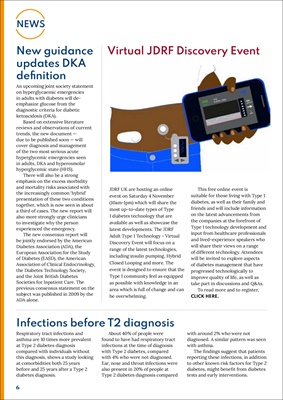
6
NEWS
Infections before T2 diagnosis
Respiratory tract infections and
asthma are 10 times more prevalent
at Type 2 diabetes diagnosis
compared with individuals without
this diagnosis, shows a study looking
at comorbidities both 25 years
before and 25 years after a Type 2
diabetes diagnosis.
About 40% of people were
found to have had respiratory tract
infections at the time of diagnosis
with Type 2 diabetes, compared
with 4% who were not diagnosed.
Ear, nose and throat infections were
also present in 20% of people at
Type 2 diabetes diagnosis compared
with around 2% who were not
diagnosed. A similar pattern was seen
with asthma.
The findings suggest that patients
reporting these infections, in addition
to other known risk factors for Type 2
diabetes, might benefit from diabetes
tests and early interventions.
Virtual JDRF Discovery Event
JDRF UK are hosting an online
event on Saturday 4 November
(10am-1pm) which will share the
most up-to-date types of Type
1 diabetes technology that are
available as well as showcase the
latest developments. The JDRF
Adult Type 1 Technology - Virtual
Discovery Event will focus on a
range of the latest technologies,
including insulin pumping, Hybrid
Closed Looping and more. The
event is designed to ensure that the
Type 1 community feel as equipped
as possible with knowledge in an
area which is full of change and can
be overwhelming.
This free online event is
suitable for those living with Type 1
diabetes, as well as their family and
friends and will include information
on the latest advancements from
the companies at the forefront of
Type 1 technology development and
input from healthcare professionals
and lived-experience speakers who
will share their views on a range
of different technology. Attendees
will be invited to explore aspects
of diabetes management that have
progressed technologically to
improve quality of life, as well as
take part in discussions and Q&As.
To read more and to register,
CLICK HERE.
New guidance
updates DKA
definition
An upcoming joint society statement
on hyperglycaemic emergencies
in adults with diabetes will deemphasize
glucose from the
diagnostic criteria for diabetic
ketoacidosis (DKA).
Based on extensive literature
reviews and observations of current
trends, the new document -
due to be published soon - will
cover diagnosis and management
of the two most serious acute
hyperglycemic emergencies seen
in adults, DKA and hyperosmolar
hyperglycemic state (HHS).
There will also be a strong
emphasis on the excess morbidity
and mortality risks associated with
the increasingly common 'hybrid'
presentation of these two conditions
together, which is now seen in about
a third of cases. The new report will
also more strongly urge clinicians
to investigate why the person
experienced the emergency.
The new consensus report will
be jointly endorsed by the American
Diabetes Association (ADA), the
European Association for the Study
of Diabetes (EASD), the American
Association of Clinical Endocrinology,
the Diabetes Technology Society,
and the Joint British Diabetes
Societies for Inpatient Care. The
previous consensus statement on the
subject was published in 2009 by the
ADA alone.